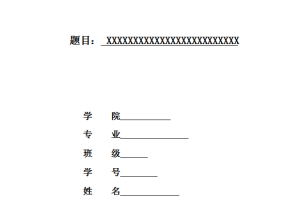Contents
Abstract………………………………………………………………………………….ⅱ
内容提要…………………………………………………………………………………ⅲ
- Business Communication
1.1 Concept of Business Communication……………………………………….1
1.2 Process of Communication………..……………………………………….1
1.3 Basic Forms of Communication in Business…………………………….5
1.3.1 Oral Communication…………………………………………………. 5
1.3.2 Written Communication…..…………………………………………..6
1.3.3 Non-Verbal Communication………………………………………8
1.4 Goals of Business Communication……………………………………….9
1.4.1 Receiver Understanding………………………………………………9
1.4.2 Receiver Response…………………………………………………..10
1.4.3 Favorable Relationship………………………………………………11
1.4.4 Organizational Goodwill…………………………………………….11
1.5 Business Communication Principles………………………………12
1.5.1 Clearness….…………………………………………………………13
1.5.2 Conciseness..…………………………………………………………17
1.5.3 Correctness..………………………………………………………….18
1.5.4 Concreteness.…………………………………………………………20
1.5.5 Courtesy………………………………………………………….… 21
1.5.6 Consideration….……………………………………………………..24
1.5.7 Completeness….……………………………………………………..25
- An Overview of Business Letters
2.1 Definition of Business Letters…………………………………………..……………28
2.2 Roles of Business Letters…………………………….….……………28
- Stylistic Features of Business Letters
3.1 General Views on Style………………………………………………………………..42
3.2 General Stylistic Features of Business Letters………………………….43
3.3 Lexical Features……………………………………………………………………….43
3.3.1 Heavy Use of Familiar Words.………..…..………………………….43
3.3.2 Extensive Use of Abbreviations……………………….….…………………45
3.3.3 Elimination of Business Clichés………..………..……………………..48
3.3.4 Economy of Words…….…..…………….…….……….………………51
3.3.5 Preference for Positive Words to Negative Words…………..………53
3.3.6 Avoidance of Sexist Wording…………………………………………54
3.3.7 Use of Concrete rather than Abstract Words……………………….56
3.4 Syntactical Features………………………………………………..….…….57
3.4.1 Variation in Sentence Length..……………………………….….57
3.4.2 Use of the Active Voice…………………………………………58
3.4.3 Use of Parallel Structures………………………………………60
3.4.4 Use of Dependent Clauses.……………………………………..61
3.4.5 Avoidance of Misplaced Modifiers……………………………63
3.4.6 Avoidance of Dangling Modifiers..……………………………63
3.5 Paragraphical Features…………………………………………………………….…64
3.5.1 Paragraph Length….……………………..….…………………..65
3.5.2 Paragraph Unity………………………….….…………………………65
3.5.3 Paragraph Coherence………..………………………………………66
3.5.4 Paragraphing of the Body of Business Letters………..……….66
Conclusion………………………………………………………………………68
Bibliography…………………………………………………………………………69
Acknowledgements
I would like to give special thanks to my supervisor Professor Zhang Chunhong for his continuous guidance from the preparation to the completion of this thesis. Professor Zhang devoted much of his precious time scrutinizing my thesis chapter after chapter. Without his help, I could not have achieved anything desirable. I also would like to show my deep gratitude for all the faculty members in SIFT’s Language School, whose excellent scholarship has made my two and half years of study an unforgettable experience in my life. My sincere thanks also go to my roommates and friends, who are always ready to offer me their enthusiastic assistance and encouragement. Finally, I wish to thank my parents, for always being close to me, standing by me, giving me strength and motivation, and so much more. Abstract With the impetus of economic globalization, international trade is witnessing rapid progress. World economies are becoming increasingly interconnected and international trade is no longer a matter of bilateral economic activity between countries. Business letters, an actively operative means of communication used in overwhelming numbers, are acknowledged as an indispensable part of international business ever more popularly even in this age of electronic communication. The writer of this dissertation targets “business letters” as the main topic, hoping to explore this subject, which is so far under-studied yet deserves greater researching efforts, from a business communication perspective, with particular emphasis on their stylistic features. This thesis consists of three chapters. In Chapter Ⅰ, the writer expounds the basic theories on business communication, including its concept, process, goals, basic forms and principles. Chapter Ⅱ is devoted to the essentials of the business letter, covering its definition, parts, categorization, roles and format, to prepare the ground for the detailed analysis in the following chapter. Chapter Ⅲ presents a comprehensive stylistic analysis illustrated and supported by a laboriously-selected number of examples. This chapter probes into not only the general features, but also the lexical, syntactic and paragraphical features of business letters. Key words: Business Communication, Business Letters, Style 内容提要 随着全球经济一体化进程的推动, 国际商务向前迅疾发展,企业之间相互联系与沟通的机会越来越多,国际贸易越来越趋向多边化。全球经济一体化期待商务沟通无障碍。商务书信作为商务沟通的一种方式,越来越成为商务活动中不可缺少的一部分。
由此, 本文选定 “商务书信”作为研究对象, 分析了其构成、作用等, 并着重从商务沟通及文体角度分析其特点,使商务书信语言更加有效地传递信息以达到有效沟通的目的。
本文分三章。第一章分析了商务沟通的基本理论,包括商务沟通的概念、过程、基本形式、目标及其准则。第二章介绍了商务信函的定义、 构成 、 分类、作用等理论知识,为下一章具体分析其文体特点做了铺垫。第三章是本文论述重点。本章结合大量例子对商务书信的文体特点进行全面细致的分析, 包括其文体的基本特点、词法特点、句法特点及段落特点。
关键词:商务沟通 商务书信 文体





